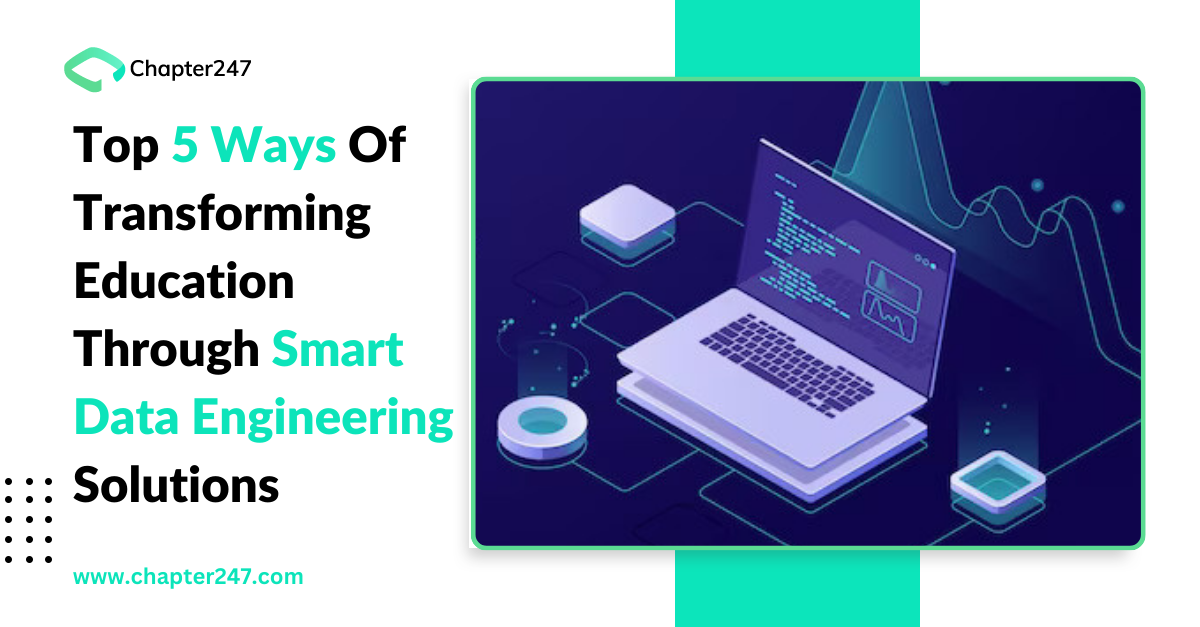In the world of education, the advancement of technology has ushered in an era of personalised learning. How it’s affecting the future? It caters to the robust requirements and learning styles of every student with unprecedented ease. Among the pivotal techniques pushing this transformation is data engineering.
Through the enhancement of data engineering into education technology, educators are reshaping the field of the education sector. A survey from Research and Markets shows that the global EdTech market is expected to grow by $404 billion by 2025. And data engineering plays a crucial role in its growth.
Table Of Contents
1. 5 Ways Data Engineering Should Transform Education Smart
- Dedicated To Student-Centered Learning Approach
- Educational Core Will Receive the Appropriate Focus
- The Digital Transformation and Innovation Is Driven By Data
- Creating Student Success Using Predictive Analytics
- Crafting a Digital Learning Roadmap
2. Conclusion
What exactly is data engineering? It is the process of acquiring data from different sources and transforming the raw information to extract meaningful data, that ultimately addresses real-world problems. A study from McKinsey & Company shows that schools that are using data-driven strategies saw a 20% to 40% enhancement in student achievement.
Learning institutions include schools and universities. All the vast amounts of student data–academic records, grades of assignments, examination results, personal and cultural interests, and more–all things are managed and monitored.
With the help of big data analysis tools which include online learning management systems, educational apps, and virtual classrooms, data engineering pushes educators to develop high methods for student learning. The Americas EdTech & Smart Classroom Market, which was valued at USD 37,005.81 million in 2021, is predicted to grow to USD 44,208.97 million in 2022 and USD 117,889.90 million by 2027.
Now, the pertinent question arises: How is data engineering revolutionising the education sector, and in which way EdTech leverages it to offer data-driven learning? Let’s take a deep dive into the 5 impactful ways data engineering enhances student retention and the success of the education sector. Moreover, we also explore more effective strategies to cultivate more connected and efficient educational experiences.
5 Ways Data Engineering Should Transform Education Smart
One of the industries that are increasingly benefiting from data-driven insights is the education industry. Are you ready to shape the future? Let’s discover how data engineering is helping to make education smart.
I. Dedicated To Student-Centered Learning Approach
With the immediate change in the remote learning model, a strong rise in graphs is seen as students complete their lessons and projects at their own speed. This asynchronous learning helps students to learn freely and in a flexible time.
The greatest impact is observed in the development of individualised learning paths. EdTech platforms develop technologically advanced and data-driven software that helps and empowers teachers to develop and deliver customised interactive, and innovative learning. Students who are data-savvy may immediately see not just the market’s value, but also the possibilities for extracting critical value from all of the generated information that is captured, shared, and analysed.
The Asia-Pacific EdTech & Smart Classroom Market was valued at USD 28,255.26 million in 2021 and is expected to grow to USD 34,699.50 million by 2022, at a CAGR of 22.40%. The market is estimated to grow to USD 95,029.96 million by 2027.
II. Educational Core Will Receive the Appropriate Focus
Educational institutes need to adopt advanced technology with a dedicated focus on increasing their educational core. Fortunately, with the ongoing technological advancements, educators remain the most important aspect of the learning process. Authentic student connectivity, high-quality educational notes, and technological tools are the most required things for positive learning.
Through a mixed-learning approach, content such as videos, eBooks, audio, translators, and dynamic assessments will make the job easier for educators. The exciting fact is that according to exploding topics the value of the corporate Edtech industry is $27.5 billion.
III. The Digital Transformation and Innovation Is Driven By Data
The aim today is to respond to the current phase by developing a more purposeful and collaborative approach, gaining influence, and developing an appealing digital plan with a common vision to utilise technology’s power to propel the company into a new digital future. Data analytics enables schools to understand and respond critically to the different demands of their students.
By providing remote and mixed capabilities in the years to come, institutions can creatively employ digital investments to meet these forthcoming difficulties and differentiate their efforts. As the world continues to adjust to the demands of agility, institutions are facing a substantial shift in attitude and practice, driven by too-rapid innovation and the status quo. Institutions may connect their activities with their goals, visions, and approaches by developing comprehensive analytical plans that represent significant areas of concentration.
IV. Creating Student Success Using Predictive Analytics
Institutions can use models of predictive analytics to collect historical data in order to monitor student performance and behaviour. These algorithms can forecast whether pupils require attention, are disengaged, or are likely to flourish in specific topics.
Such crucial foresight allows educational organisations to successfully implement focused interventions, extend supplemental resources, and, eventually, improve their students’ overall performance. A survey from Emergen Research shows that the adaptive learning market size is expected to grow $9.11 billion by 2028.
V. Crafting a Digital Learning Roadmap
Sounds effective? The global coronavirus pandemic had felt tremendous impact on the educational sector. Lots of students miss their classes and this impacts their educational grades. This nearly two years of gap in education causes major losses in education. However, many business tycoons discover this crucial problem and try to resolve it successfully. Organisations adopted digital technology to enhance their capacity for insights and discover critical gaps.
The combination of data-driven technologies allows companies to incorporate novel methods for combining them. This results in a technique that provides critical knowledge quicker and more efficiently. Moreover, the knowledge must be sent to the targeted areas. It also enables institutions to discover students learning gaps and take efficient steps to close them quickly.
Conclusion
Data engineering has and continues to profoundly alter the education landscape. Its significance is evident, spanning curriculum development to individualised learning experiences, early intervention, and predictive analytics. If you’ve found this article helpful and are seeking assistance with data engineering, don’t hesitate to reach out to Chapter247 for expert guidance and support on your journey to harnessing the power of data in this industry. So, let’s start your journey.








